Randy Walker originally studied Architecture at the University of Oregon and as an artist has completed temporary and permanent commissions all across the United States of America.
The recipient of many grants and awards Randy’s work straddles precariously on several boundaries: solidity and transparency; structural stability and collapse; visibility and invisibility.
He strives to create work that primarily engages our sense of sight by contemplating how light can define structure, surface, and colour.
In this interview, we discover what fires Randy’s imagination and how his background in architecture has shaped his artistic vocabulary. We learn about his commissioned work and how he puts together his subtle yet mind blowing installations.
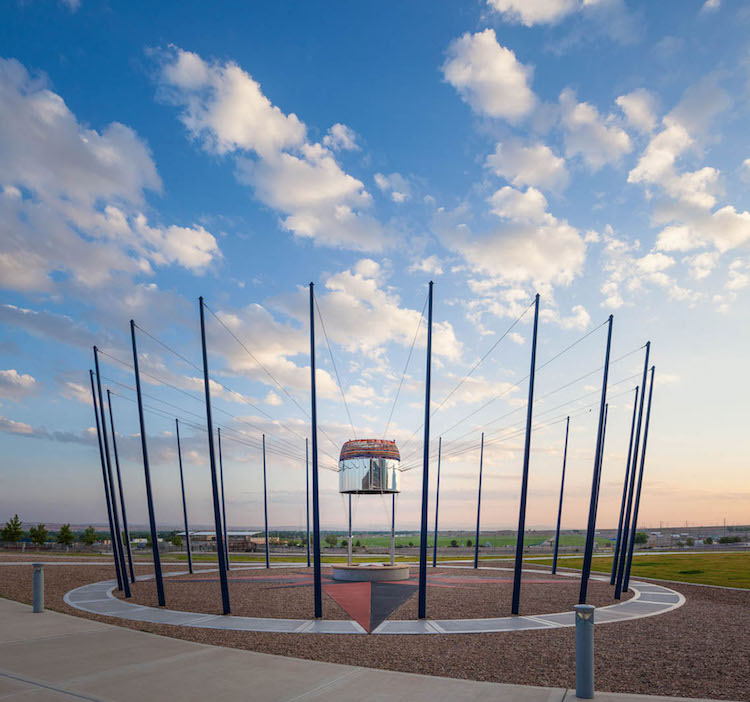
Intricately woven networks
TextileArtist.org: What initially attracted you to textiles as a medium?
Randy Walker: Initially, I was fascinated by what I perceived to be fibre’s lack of materiality. Coming from a background in architecture, I was accustomed to thinking about wood, steel, concrete, glass.
Fibre seemed so insubstantial, almost not there. Before I began working with fibre, I thought of textiles as solid planes, not as intricately woven networks.
And, more specifically, how was your imagination captured by stitch?
Before I could appreciate textiles for what they were, I had to follow a journey that began with individual strands of fibre.
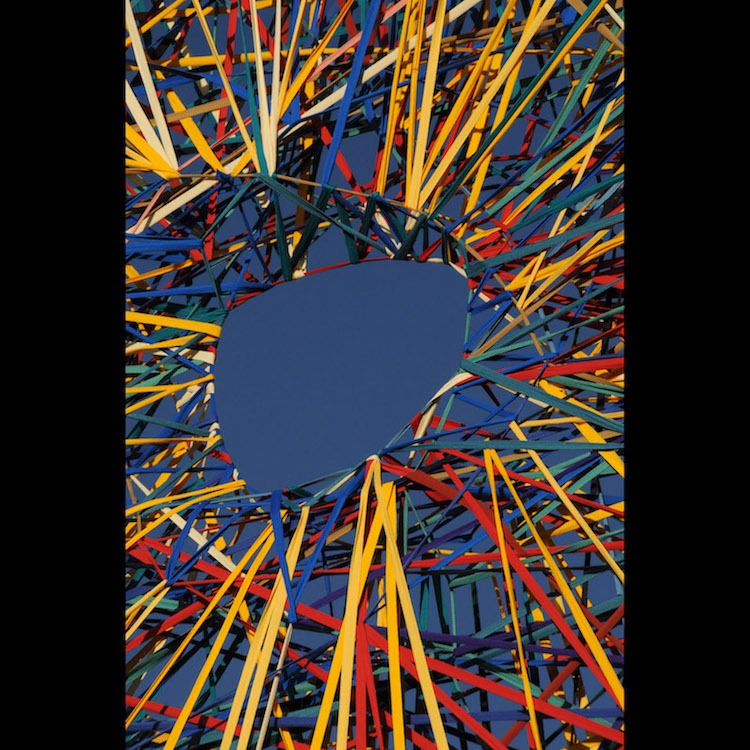
My imagination was truly captured when I started to wrap and weave found objects with thread. Once in tension, the lines of fibre began to speak to me on a level more familiar to my architectural sensibility. Reflected light; vector-like lines; points of attachment, I saw the potential for creating complex spatial works through accumulation and repetition.
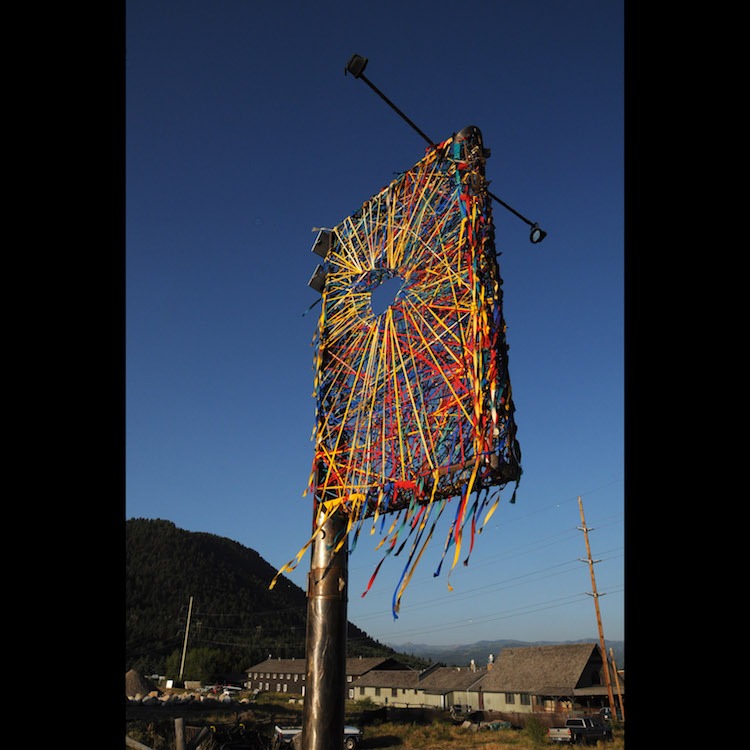
The found object was the ‘site’ of the work, and just as in a work of architecture, the object defined the parameters and dictated what was possible in each specific case. It was really about discovery.
ArtSpot
Completed: 2013
Location: Jackson Hole, WY
Commissioning Agency: City of Jackson Public Art
Dimensions: 20’ x 11’. Temporary installation
Materials: Existing steel armature, acrylic fibre braid
The installation was completed using a steel frame fabricated by another artist. To fill the empty space, I worked with youth and community members and let the work evolve organically.
As we worked, a void emerged and ended up being a frame to the sky and landscape beyond.
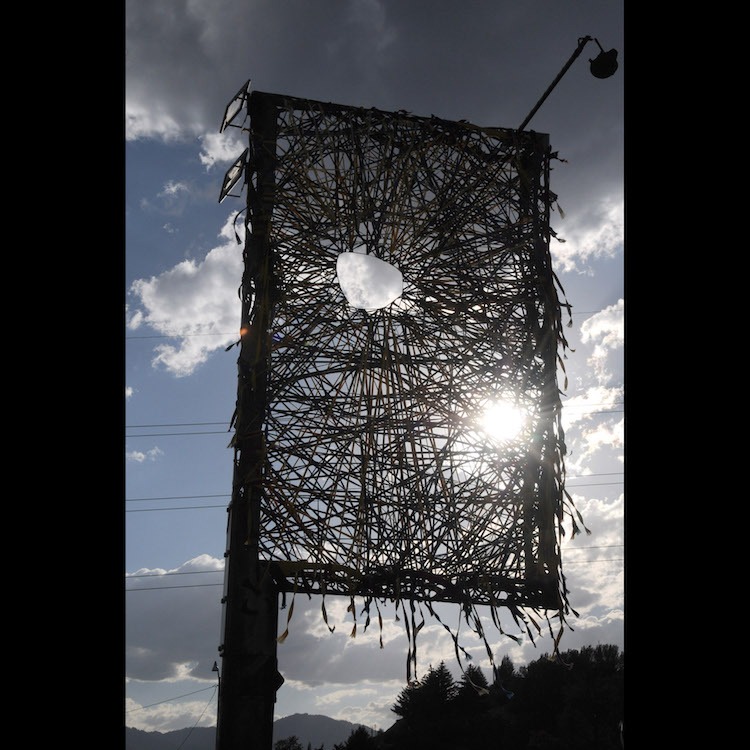
What was your route to becoming an artist?
From a very early age, I dreamed of becoming an architect. I pursued this path through university and beyond, working in various offices in Portland, San Francisco, and Prague. At some point, architecture wasn’t doing it for me. I wanted to create more directly, more quickly, and more intuitively.
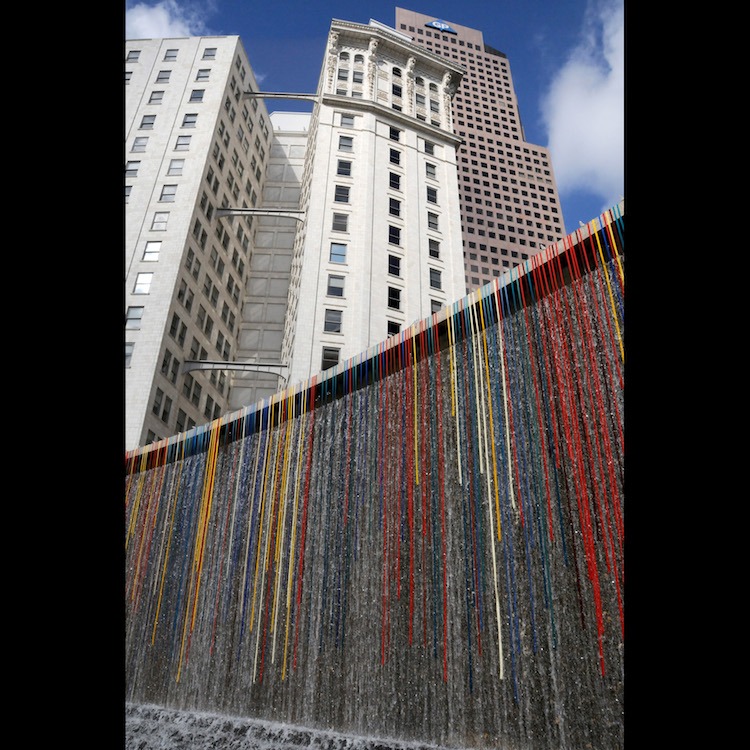
I decided to devote a small amount of time and space each week to artistic exploration. I had always drawn and built things but didn’t have the resources to fabricate things, so I started scavenging old pieces of junk, saw blades, kitchen utensils, tools, etc. I’d alter them by combining things, removing pieces, or adding new materials. There seemed to be rules based on what I was working with, a kind of particular nature to each object.
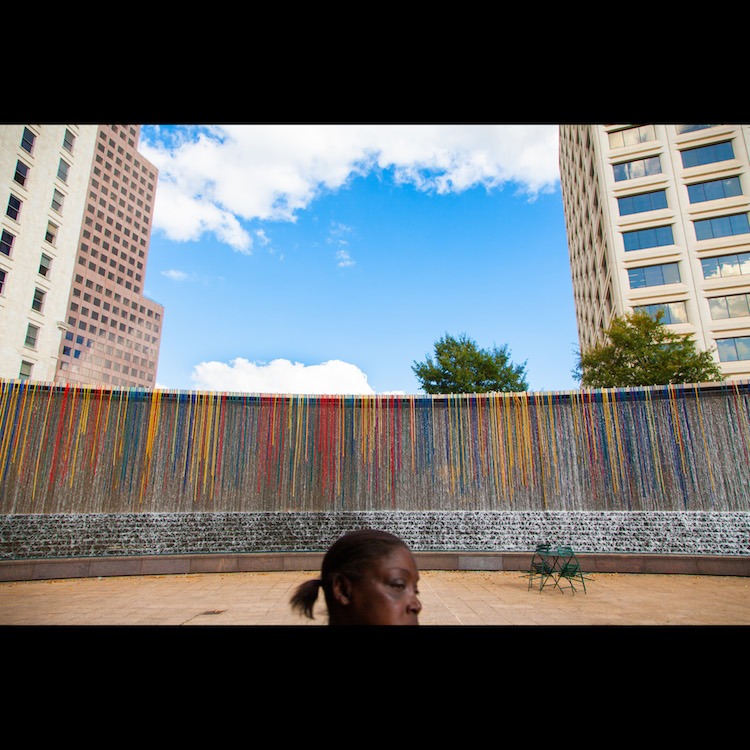
Color Falls
Completed: 2011
Location: Woodruff Park, Atlanta, GA
Commissioning Agency: Atlanta Office of Cultural Affairs
Dimensions: One city block
Materials: Acrylic fibre braid
Color Falls was a temporary installation in which the artist and assistants transformed this downtown icon into a wall of colour. The fibre was immersed in the fountain and held to the wall by surface tension. The park has been the site of civil rights protests and one of Atlanta’s memorable public spaces.
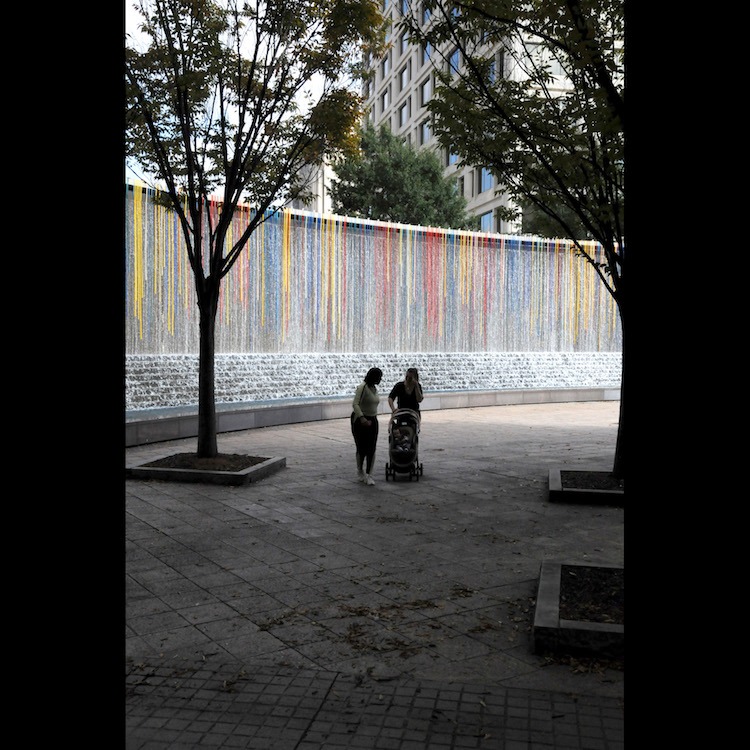
Where mysteries reveal themselves
Tell us a bit about your chosen techniques.
As far as technique, I can tell you that I’m a lousy fibre artist. In small work, I am usually wrapping, weaving, attaching any way I can, improvising and sweating a lot when I’m confronted with a simple tie-off situation.
My work has been shown over the years in galleries alongside some truly accomplished fibre artists who have mastered and pushed the boundaries of fibre beyond traditional notions of fine craft. I am always in awe of someone who has mastered a craft to a high degree.
In the larger scale public, I create, my techniques start to be informed by structural engineering and installation considerations. For example, while a thread can be tied off to an almost invisible knot, a steel cable is a different matter, so I end up looking for artistic potential in materials such as turnbuckles, and fasteners.
I see this as a logical and necessary evolution of the work as it crosses the threshold of temporary to more enduring work.
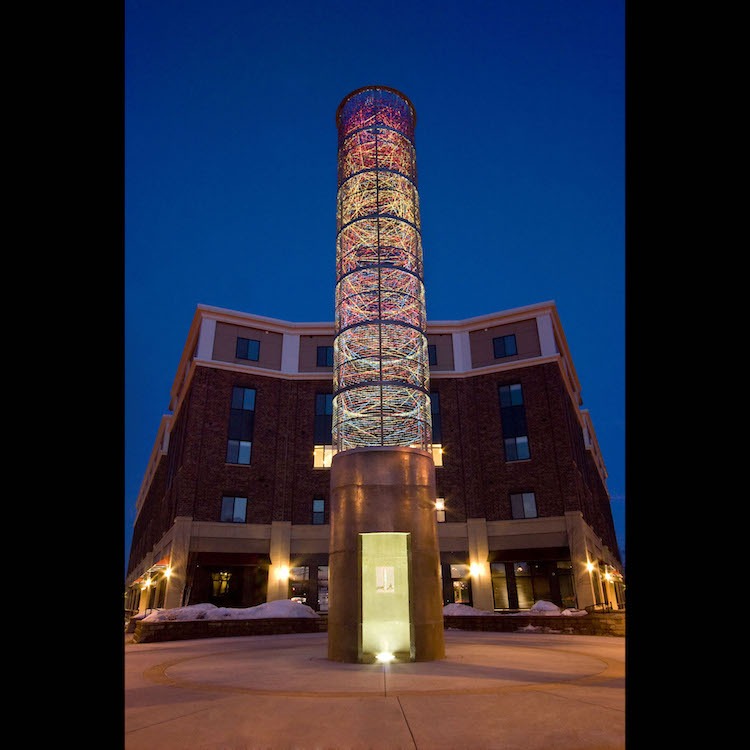
How do you use these techniques in conjunction with embroidery and sculpture?
Okay, I had to look up ’embroidery’ to make sure I knew exactly how to answer. To the extent that embroidery involves the use of a needle and thread, I can tell you that at some point, I discovered the needle for myself out of sheer necessity.
Namely, I became interested in ‘weaving’ three-dimensional space with strands of fibre. Using a framework like a gridded metal mesh, I needed to use long needles to pass the fiber back and forth. I remember at some early point taking a narrow wooden dowel and sharpening the end like a pencil then drilling a hole in the opposite end. That’s when it dawned on me that I was actually making a needle.
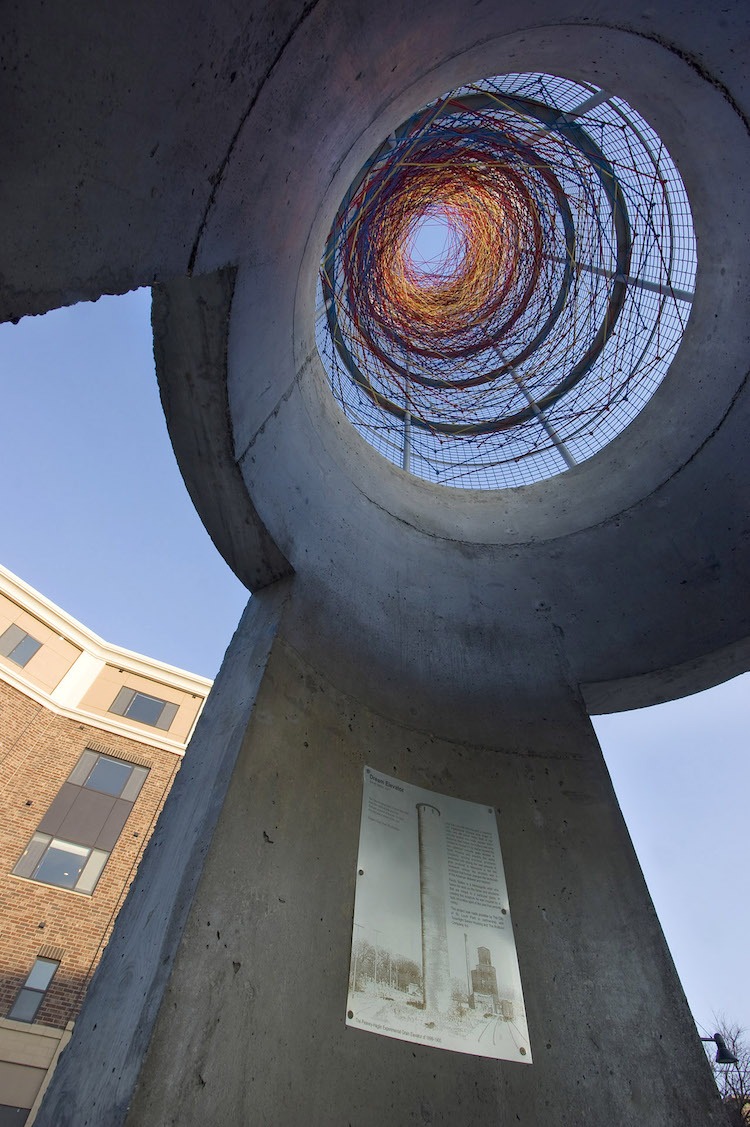
Dream Elevator
Completed: 2012
Location: St. Louis Park, MN
Commissioning Agency: City of St. Louis Park, MN
Dimensions: 44’ x 7’ diameter
Materials: Precast concrete, stainless steel, custom polyester, illumination
The sculpture consists of a tall cylindrical tower made of a precast concrete base and stainless steel wire mesh structure, woven with custom marine-grade fibre and accessible by three doorways at the base.
The form of the sculpture is inspired by the nearby Peavey-Haglin Experimental Grain Elevator of 1899, the first cylindrical concrete grain elevator in the world, which still stands. Inside the sculpture, the sky is framed through a single view through the cylindrical stainless steel mesh structure.
The artist worked with both the landscape architect and building architect to ensure that the sculpture, plaza, and building would be cohesive.
Looking for frameworks
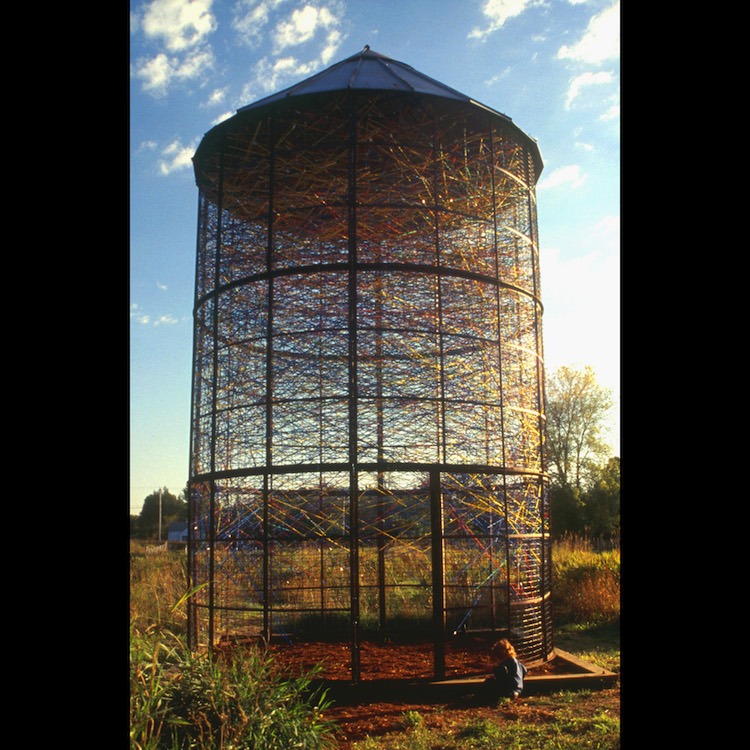
How would you describe your work and where do you think it fits within the sphere of contemporary art?
I make small objects and large public art installations, so I am aware of the apparent chasms between craft and fine and public art spheres. While I realize that there are different traditions that define these areas, I’m not interested in parsing and categorizing work.
I am inspired by the potential for overlaps, intersections, and anomalies. Leaving the safety of well-defined categorizations is surely where mysteries reveal themselves.
Do you use a sketchbook? If not, what preparatory work do you do?
I use a sketchbook primarily to draw ideas in a loose, searching way. I’m often sketching to solve a creative problem. Not necessarily pretty drawings.
Earlier in my career, I sketched more of the world around me, and I would like to return to that practice at some point. There is so much value in the way you look at something as you sketch it.
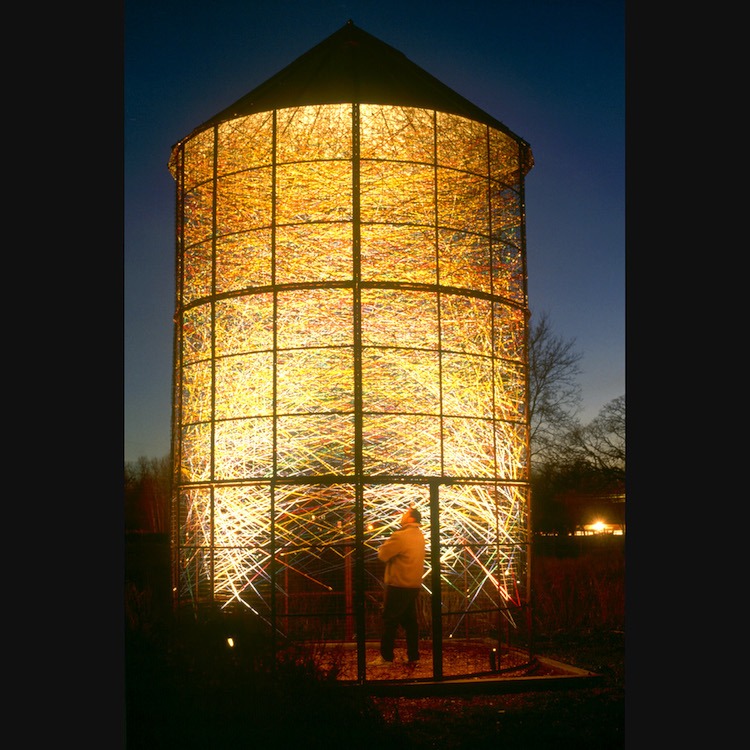
Tell us about your process from conception to conclusion.
When I create work, from a small scale studio piece to a large public installation, I am looking for frameworks or limitations that will define the moves I make.
At a small scale, these artistic moves might be how I will get a needle and thread through a material and where I can physically reach my hand.
On a large scale, the moves might involve landscape design, fabrication concerns, or budgets.The frameworks are always particular to an object, site, or community. The work grows out the givens. A small studio project might take weeks to complete and a large public work could take years.
What environment do you like to work in?
I work in a small studio that I reach by walking through my garden. I am surrounded by books, spools of fibre, small experimental works, and scale models. When I work at the computer, I walk on a treadmill. It’s kind of a cross between an architect office and artist studio.
I enjoy working directly on site to install work. The excitement, anticipation, and spontaneous problem-solving required is exhilarating.
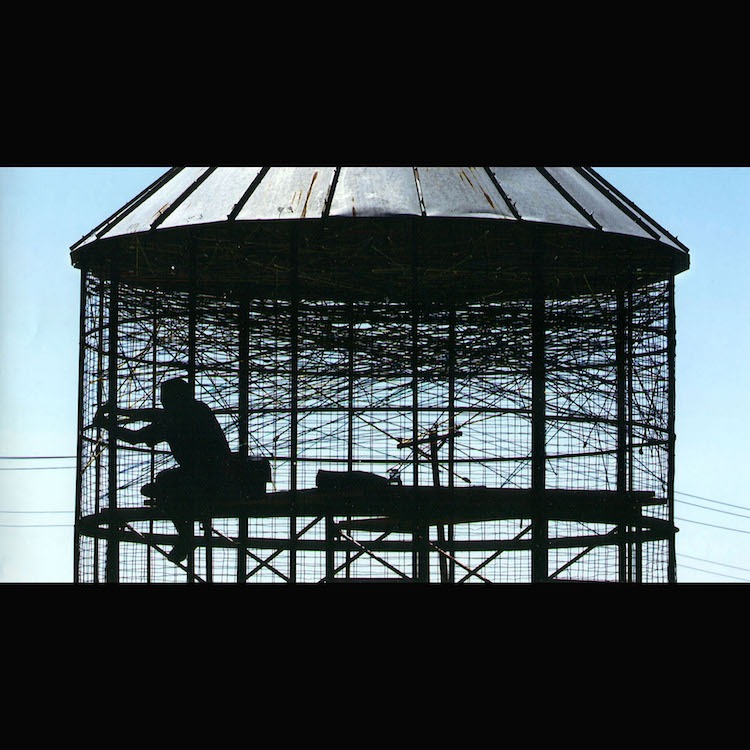
Woven Corncrib
Completed: 2004
Location: Falcon Heights, MN
Commissioning Agency: Minnesota State Arts Board
Dimensions: 13.5’ diameter x 25’
Materials: Salvaged corncrib, salvaged synthetic rope
An obsolete and decaying agricultural structure from a working farm in rural Minnesota was dismantled and relocated to an open-air history museum, where the artist wove the structure with salvaged fibre rope over the course of a summer.
The installation was intended to highlight the inherent architectural beauty of this common utilitarian structure by transforming it into a temporary artistic experience.
From denim mill to woven park
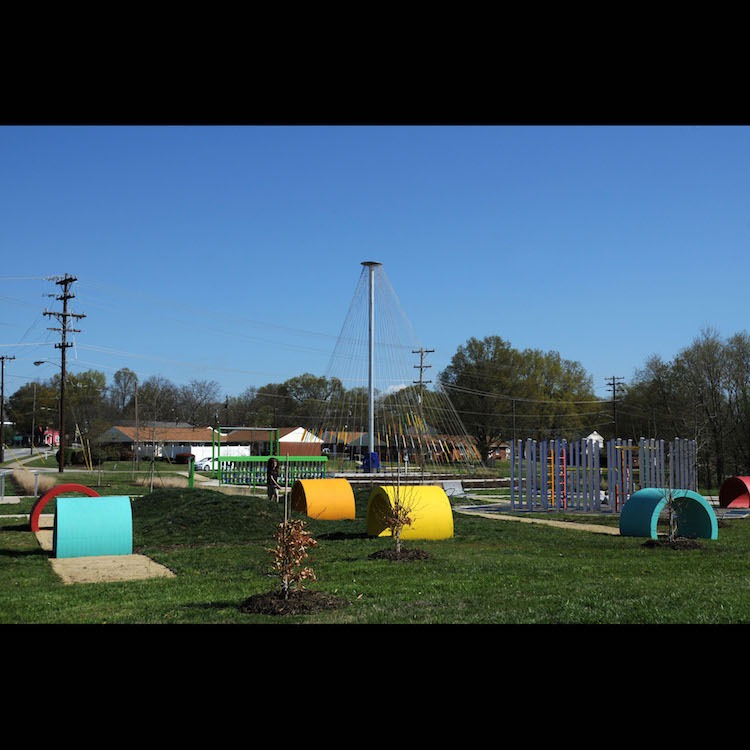
What currently inspires you?
I recently completed a large public project for the City of Greensboro, North Carolina. Named Woven Works Park, the project called for a complete landscape design, site furniture, and interactive sculptural elements, so it was by far the largest commission I had worked on to date. The theme of the 1.3-acre park was innovation as it relates to Greensboro’s textile history.
In researching the city’s cotton mills, I was particularly inspired by the White Oak Denim mill, still active today. I visited the mill and was mesmerized by the ingenious machinery used to weave denim. The mill still uses antique Draper looms to produce high-end boutique denim because modern, more efficient air-driven looms can’t replicate the ‘authentic’ imperfections that are currently in vogue.
I decided to design all the elements of the park around the ideas I encountered in the mill: spinning, twisting, weaving, spools, twill weave patterns, etc. I organized the site by overlaying a denim (twill) weave pattern over the land and letting the warp and weft yarns start to define paths, planting beds, and sculpture locations.
Within this abstract weave, I located six interactive, playable sculptures that interpreted the ideas I found in denim production. The centrepiece of the site is a spinning carousel bench underneath what appears to be a spindle being wound with fibre.
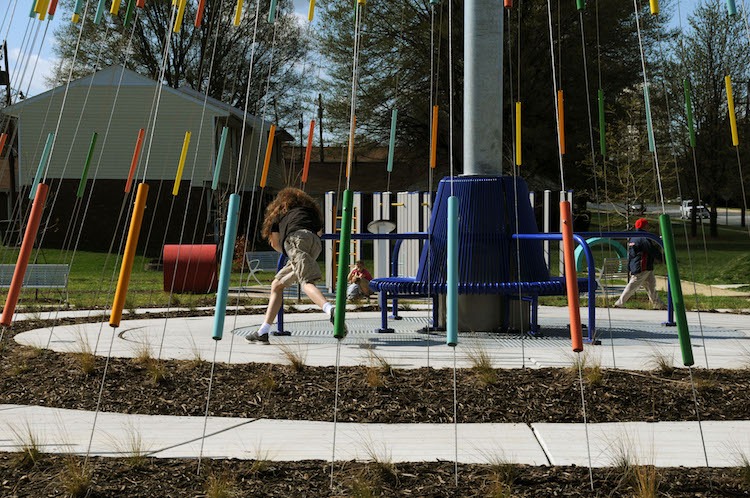
A round sandbox with a large rake structure and bicycle wheel can be pushed in circles so that the sand looks like yarns running through a loom. The resulting patterns in the sand also bring to mind a Zen rock garden. There is also a climbing jungle gym based on the twill weave in which you can move through a grid of columns painted an alternating blue and white.
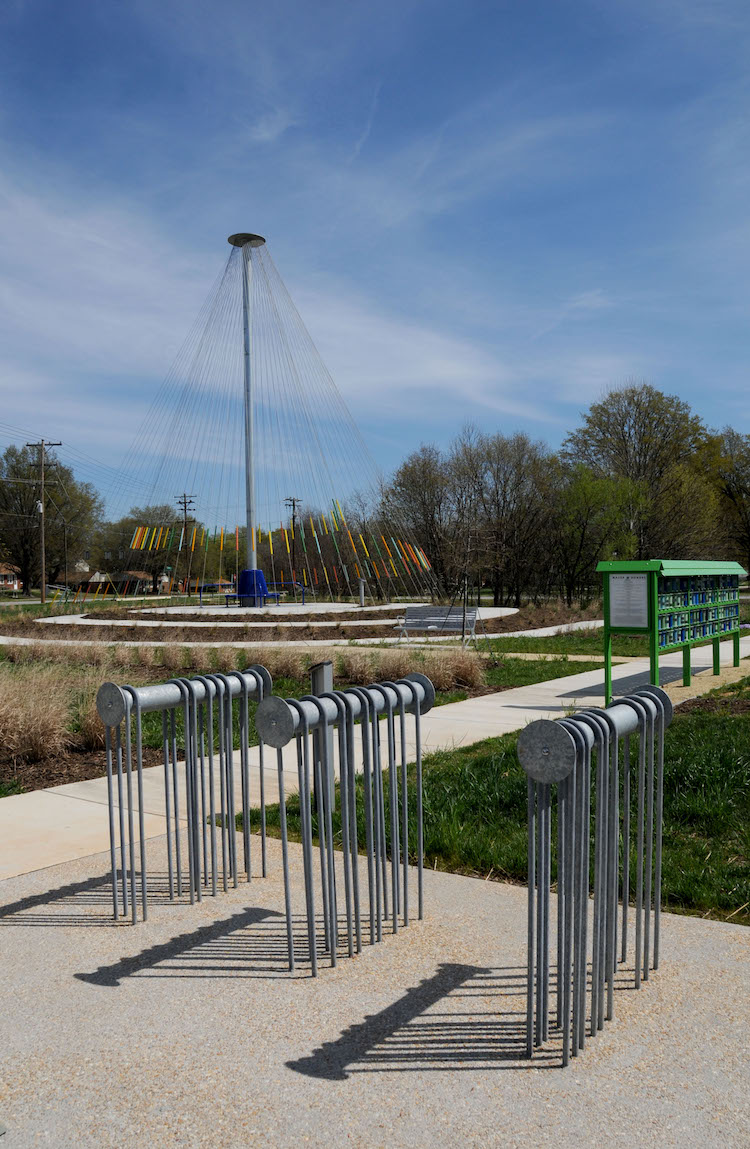
Woven Works Park
Completed: 2017
Location: Greensboro, NC
Commissioning Agency: City of Greensboro, NC
Dimensions: 1.3 acres
Materials: Concrete, steel, illumination, landscaping,
Woven Works Park is one of four major public art works located on Greensboro’s Downtown Greenway. Inspired by the city’s innovative entrepreneurial history, particularly the textile industry, the park is intended as a playful space for community members of all ages and abilities.
The park consists of paths, gardens, and six sculptural elements that take formal inspiration from processes used to produce denim fabric. The concepts of spinning, twisting, weaving were fused with traditional forms of play and movement into sculptural elements evocative of looms, yarns, bobbins and spindles.
The site is organized by a grid of paths and planting beds that replicate the warp and weft pattern that makes up the twill weave in denim blue jeans, the most famous textile still produced in Greensboro.
Within this emerging and disappearing grid, six interactive elements including a bike rack, donor recognition wall, native pollinator garden, and site furniture form destinations within the park. The artist assembled and managed a team of fabricators, civil and structural engineers, landscape architects, and contractors, overseeing all aspects of the design and construction of the project.
Revolution Cone is a 48’ tall spindle that anchors the park. Inspired by yarns being wound around a spindle, the galvanized steel pole is anchored by 101 stainless steel cables that visitors enter by way of a spiral path. The base of the sculpture is a wheelchair accessible rotating turntable carousel bench from which the city can be viewed as if being wound up in yarn.
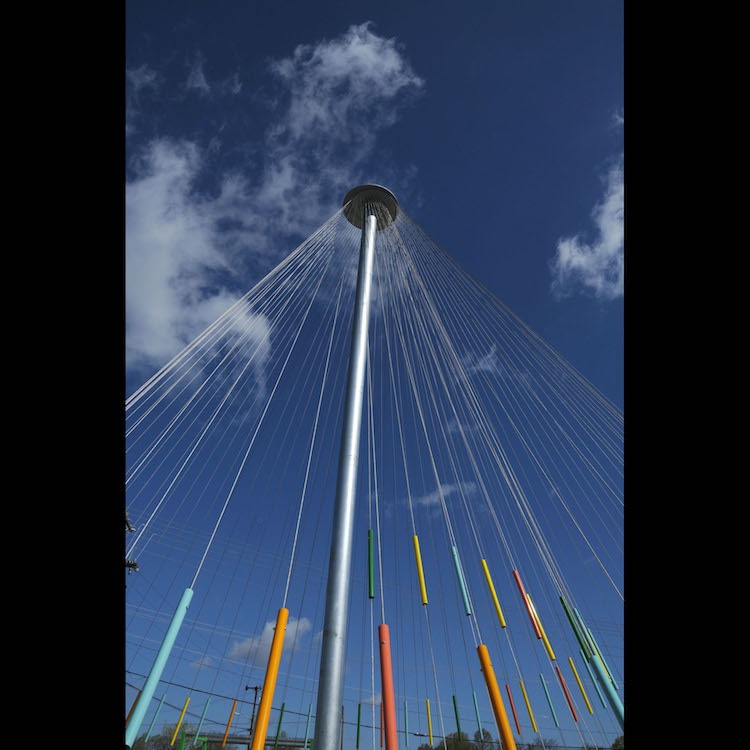
Selvedge Sandbox is inspired by the yarns passing through the power looms at Cone Mills and the bicyclists on the greenway. In this interactive sculpture, a loom-like rake can be rotated to make patterns within the sandbox.
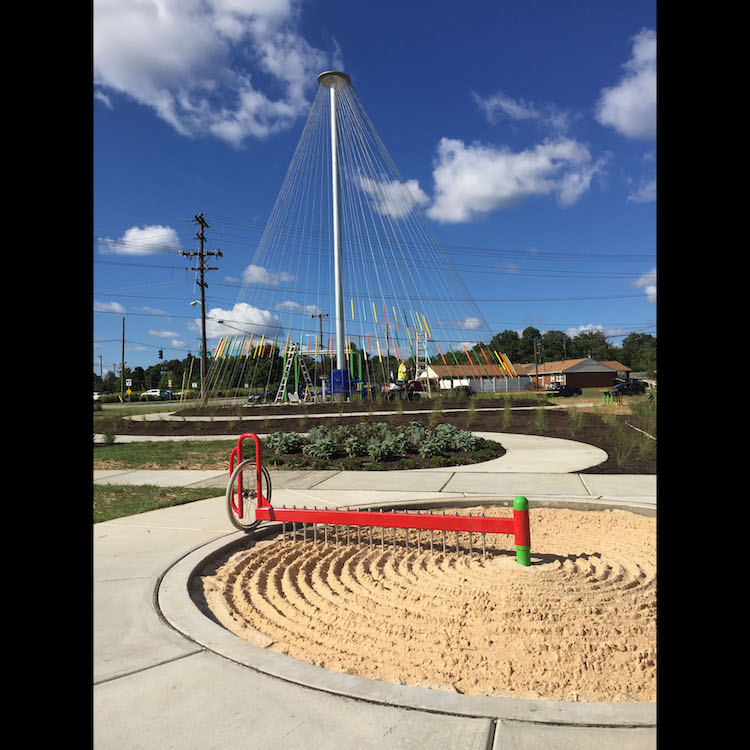
Jungle Jeans is inspired by the blue and white yarns of a denim weave, reimagined in three dimensions. A rubber play surface mimics a twill weave, as does a field of painted columns. The structure meets all safety regulations for public play structures.
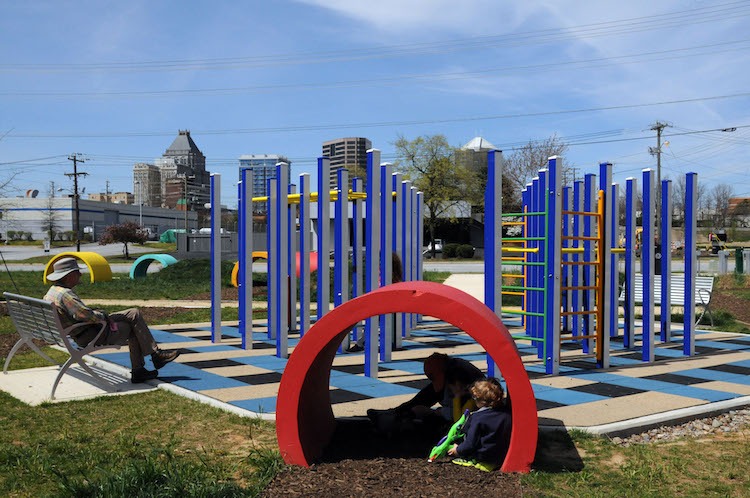
Sit and Spin is a simple seating area drawing inspiration from the iconic spinning stools at the historic Greensboro 1960 Woolworth Sit Ins, central to the Civil Rights movement.
Spool Donor Wall is an interactive wall of colour-coded spinning aluminium spools that recognizes major donors by engaging visitors to actively seek out names.
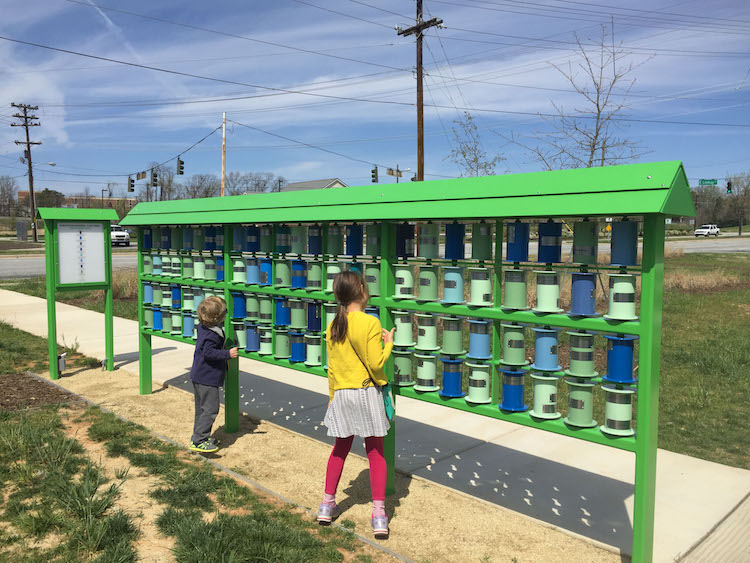
Who have been your major influences and why?
Naomi & Matsuzaku Kobayashi
Sheila Hicks
El Anatsui
Richard Serra
Leonore Tawney
Jesus Rafael Soto
Alexander Calder
Christo
Anish Kapoor
Corey Martin
I’ve listed several inspirational artists above, but there are many more. I am always inspired by artists who take a few ideas and make a commitment to explore their potential in depth.
I think it takes hard work and focus to truly engage ideas to discover their potential. I have learned that often the ideas that seem flat and simplistic in my mind are the ones worth looking at, for they hold unseen promise.
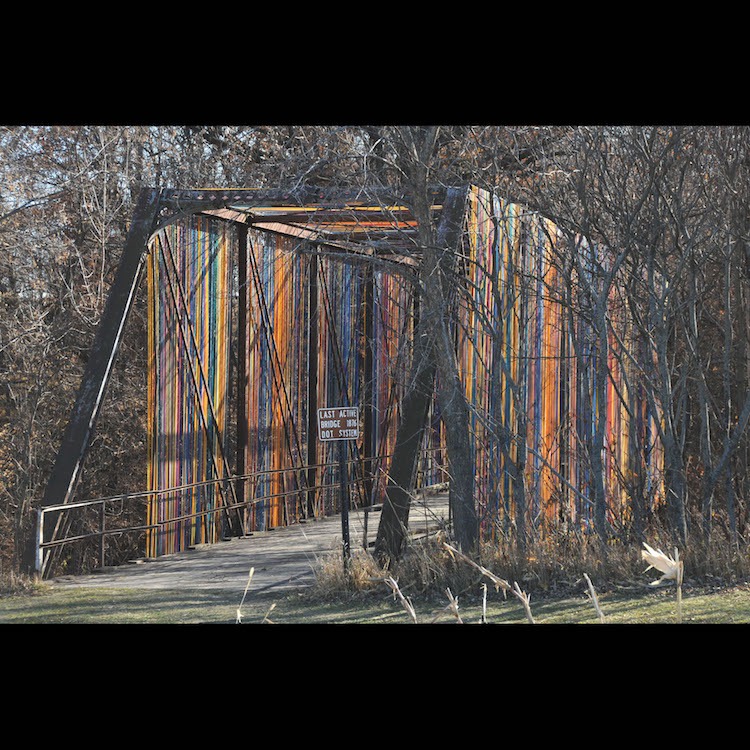
Tell us about a piece of your work that holds particularly fond memories and why?
Passage was a temporary installation I did in 2011. I received a grant to complete the project, so it was entirely self-directed.
I wanted to make an artistic intervention using a bridge as a framework, so I researched wrought iron bridges across Minnesota for artistic and practical feasibility. When I found the ideal candidate in a rural park half a day’s drive from my studio, I got myself on the agenda of the county commissioners monthly meeting to seek permission to do the project.
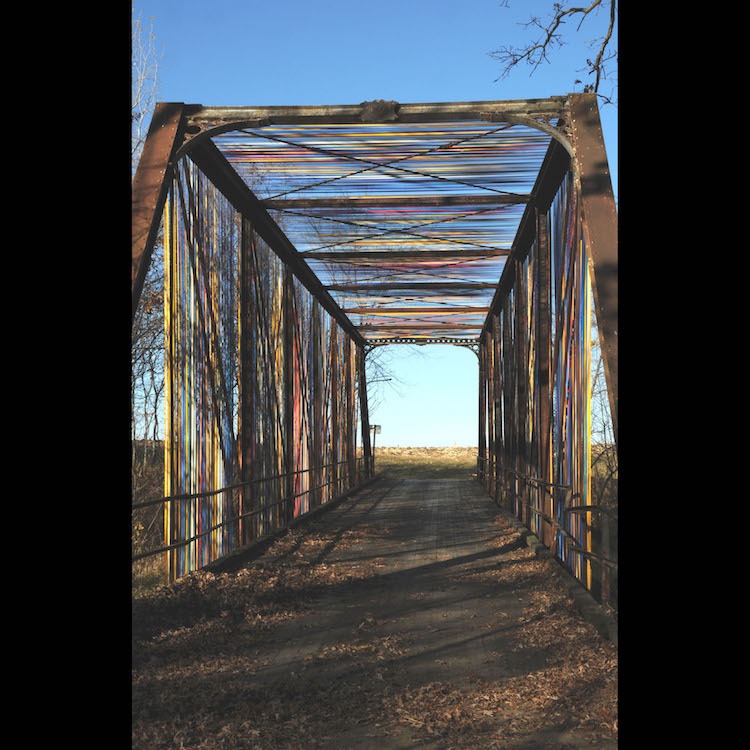
I had done research on the history of the bridge and presented conceptual renderings of the installation showing what I estimated would be around 10,000 feet of acrylic braid.
My presentation was met with awkward silence, and I was granted permission after I re-assured the commissioners I was insured.
That fall, I spent two wondrous weeks in the crisp air and changing leaves, sharing stories with the occasional passerby as I wrapped the 1873 bridge in what turned out to be 30,000 feet of acrylic braid.
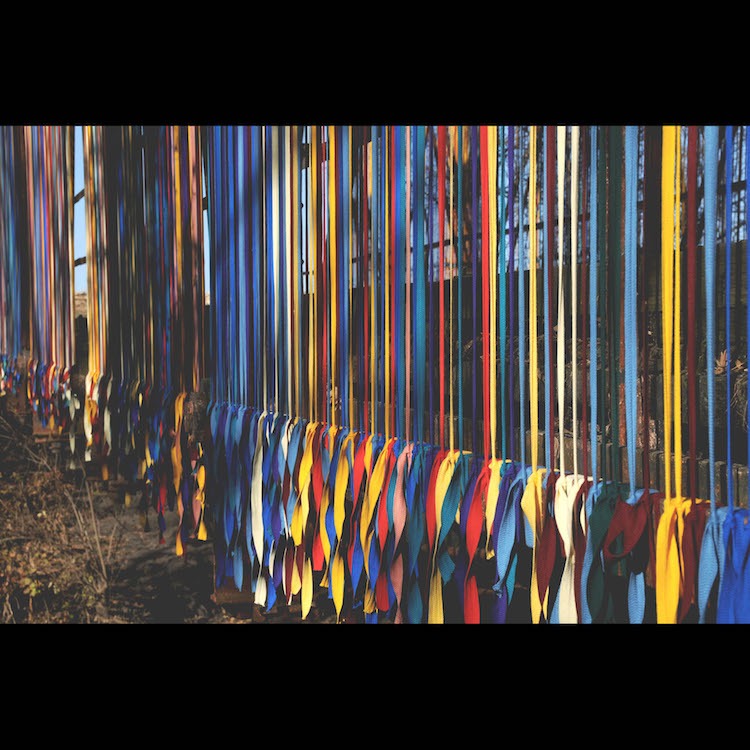
Passage
Completed: 2011
Location: Shanaska Creek, Lake Washington Park, MN. Temporary installation.
Commissioning Agency: Minnesota State Arts Board
Dimensions: 115′ x 17′ x 13′
Materials: 1875 wrought-iron bridge, acrylic fibre braid
The historic structure was transformed by wrapping over 30,000 feet of fibre braid down the length of the bridge. The bridge remained passable to the public throughout the entire installation process.
The bands vibrated in the breeze, giving the bridge an electric quality. The installation took advantage of the daylight conditions, breeze, and rural landscape in an attempt to create an artistic intervention that heightened viewers’ perceptions of the existing landscape.
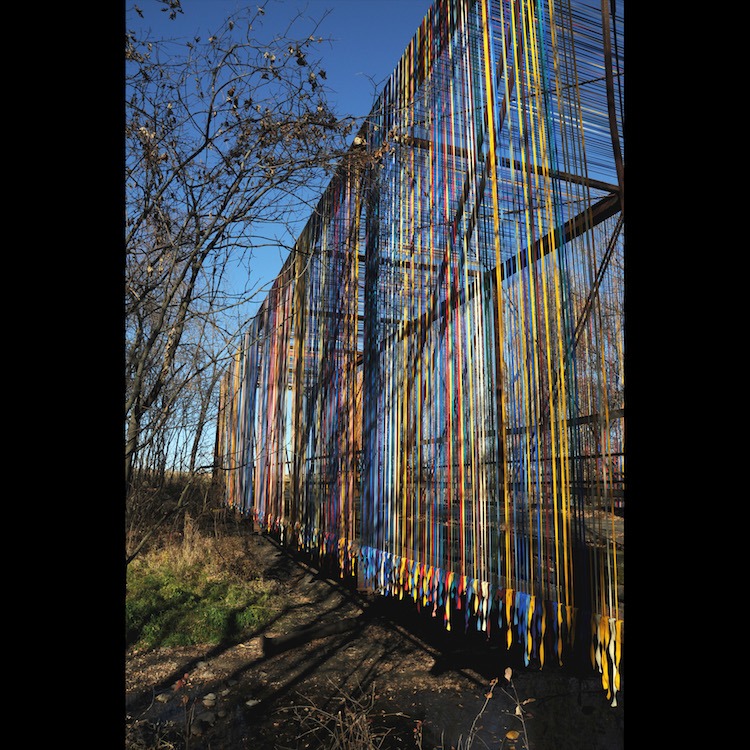
Allowing for greater freedom
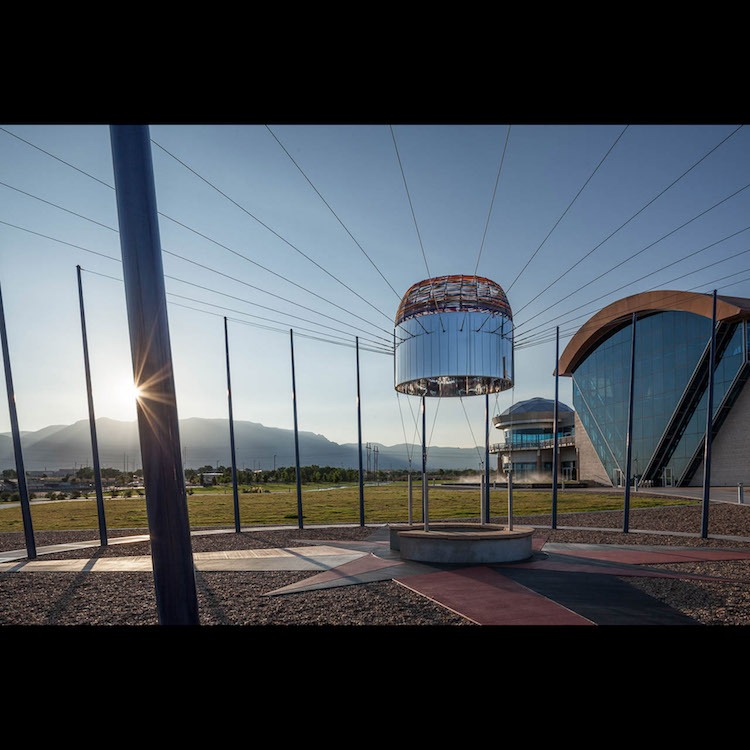
How has your work developed since you began and how do you see it evolving in the future?
The majority of my work currently is focused on large scale temporary and permanent art installations, with smaller works completed for private institutions.
When I reflect on my beginnings with a few spools of sewing thread and little else, I feel very fortunate to have made the journey to projects of the size and complexity I am involved with these days. Many of the ideas that find their way into my larger work can be traced to smaller experiments.
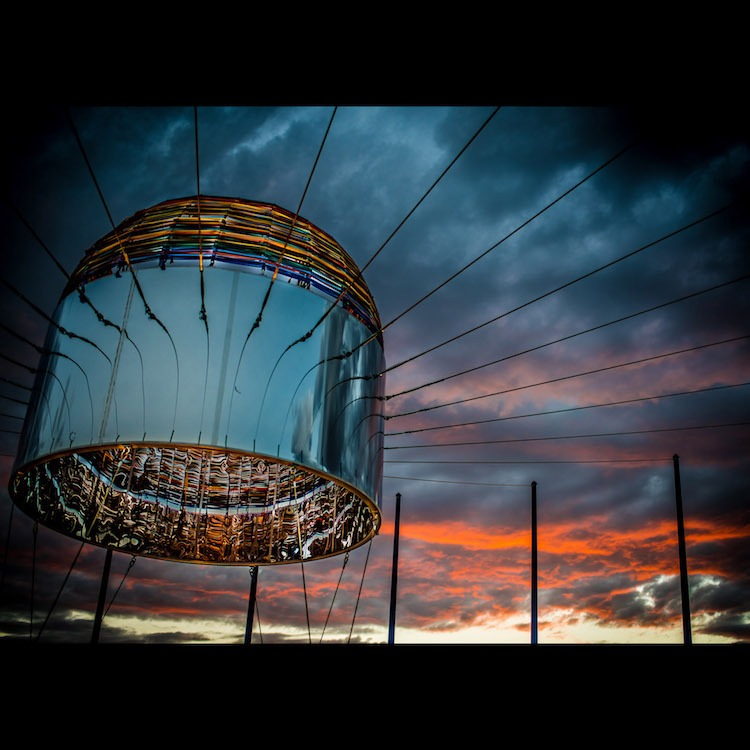
In the future, I would like to devote the time to re-engage small scale work as a more equal part of my practice. Small work allows a greater freedom to explore new media and techniques.
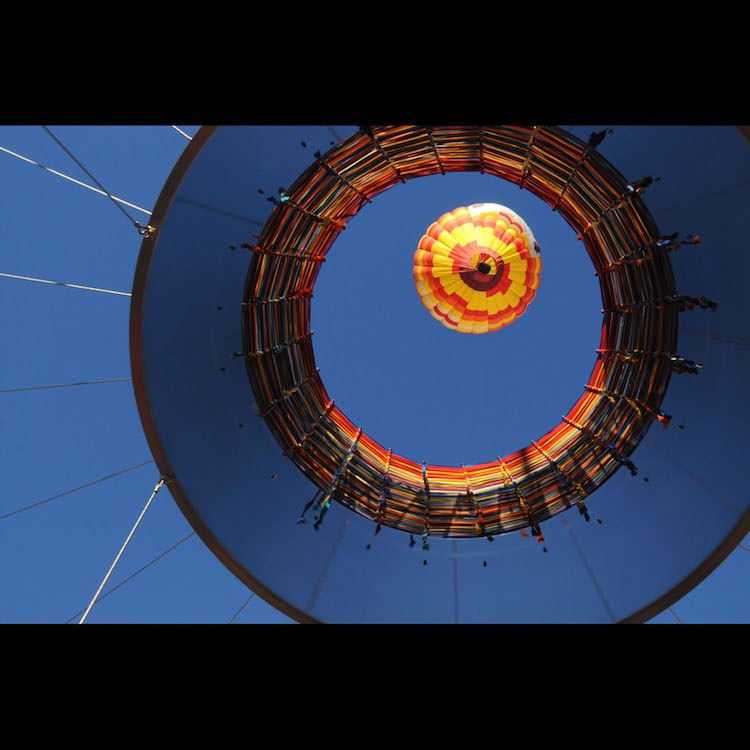
Sky Portal
Completed: 2014
Location: Anderson Abruzzo International Balloon Museum. Albuquerque, NM
Commissioning Agency: New Mexico Arts/City of Albuquerque
Dimensions: 72’ diameter x 25’high
Materials: Concrete, mirror-polished stainless steel, stone, customized utility poles, landscaping, acrylic fiber
Sky Portal is a permanent installation situated near the launch site of the largest annual hot air balloon in the world.
Inspired by the surrounding sky, landscape, and sunlight, the sculpture takes its shape from forms found throughout the history of lighter-than-air flight.
Twenty four customized utility poles suspend a mirror-polished stainless steel cylinder above a circular seating area accessed by concrete paths.
Designed to be experienced from both the ground and the sky, the sculpture creates an intimate gathering place from which to contemplate an endless sky by framing the hundreds of hot air balloons that ascend and pass above. At altitude, the sculpture reads as a compass rose to orient balloon pilots.
Step outside the givens
What advice would you give to an aspiring textile artist?
For an artist at any level, but particularly an aspiring one, I would advise paying close attention to the givens. The given techniques, traditions, expectations, purposes, and boundaries. Once you understand these givens, challenge yourself to step outside and see them in a different context.
Apply them in a way that wasn’t intended. Then work to expand your vision until the critic in you falls away and all you can see when you look toward the horizon is limitless possibility.
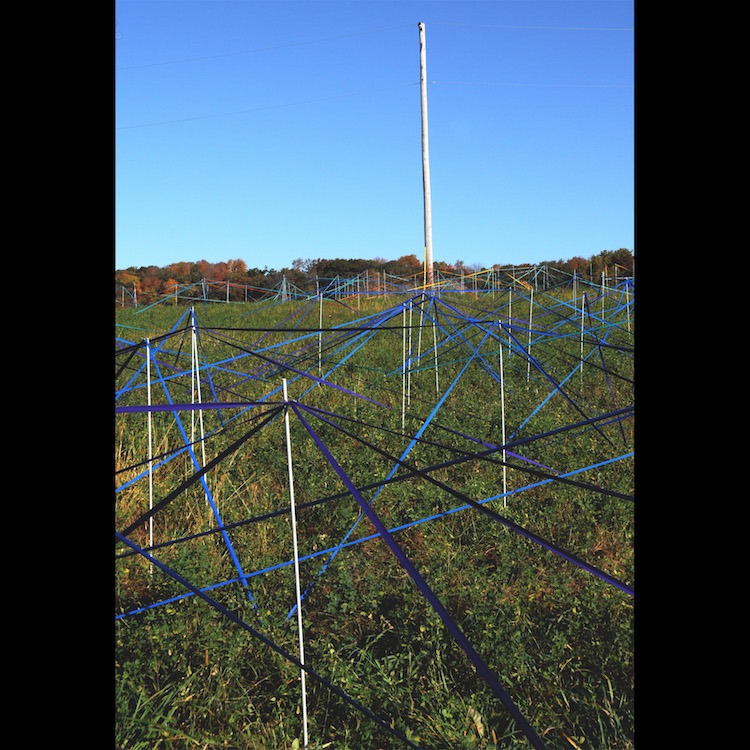
Field Weave
Completed: 2011
Location: Reedsburg, WI
Commissioning Agency: Wormfarm Institute
Dimensions: 200’ x 100’. Temporary installation
Materials: Electric fence posts, sod staples, acrylic fibre braid
Inspired by the textures found in a neighboring cornfield, I spent one week ‘planting’ posts into the earth and weaving fiber through fasteners intended to secure electric fencing material used in farming applications.
As the work became more intricate, I was challenged to move in new ways.
Can you recommend 3 or 4 books for textile artists?
[easyazon_link identifier=”0713689315″ locale=”UK” tag=”wwwtextileart-21″]The Nature and Art of Workmanship by David Pye
[easyazon_link identifier=”1585425400″ locale=”UK” tag=”wwwtextileart-21″]Catching the Big Fish by David Lynch
[easyazon_link identifier=”B00OL4C7ZM” locale=”UK” tag=”wwwtextileart-21″]The Book of Looms by Eric Broudy
[easyazon_link identifier=”0961392126″ locale=”UK” tag=”wwwtextileart-21″]Visual Explanations by Edward Tufte
What piece of equipment or tool could you not live without?
The walking treadmill, without a doubt.
Where can readers see your work this year?
Port of San Diego, California
West Memphis, Arkansas
Marshall, Minnesota
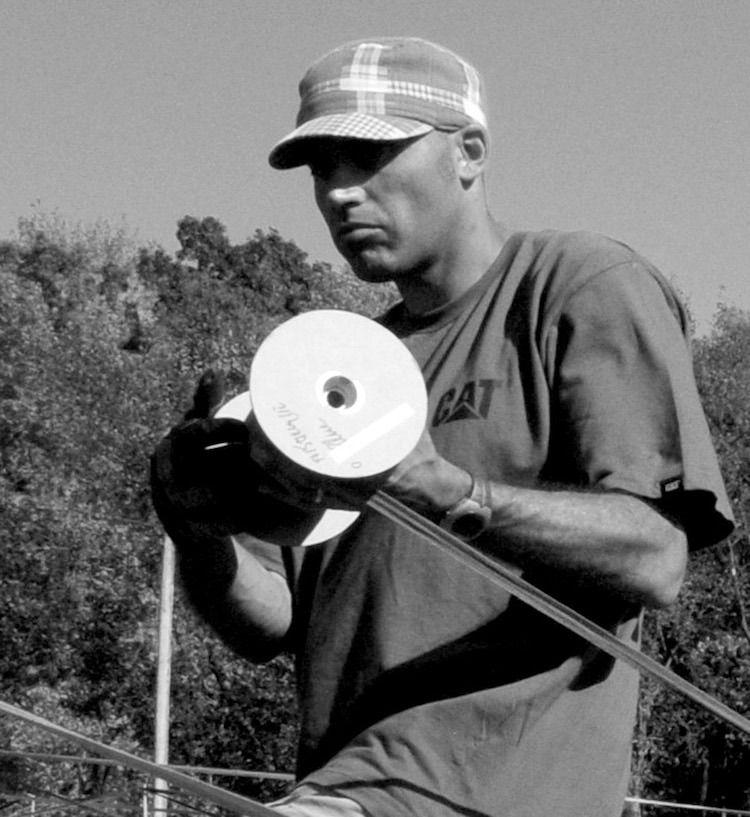
For more information visit: www.browngrotta.com
Let us know what your favourite aspect of the artist’s work is by leaving a comment below.
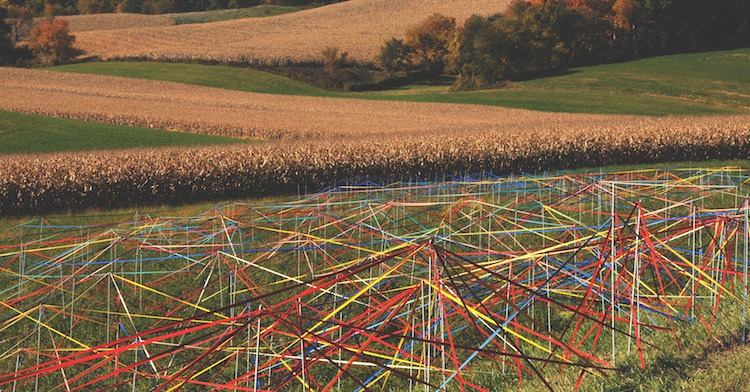
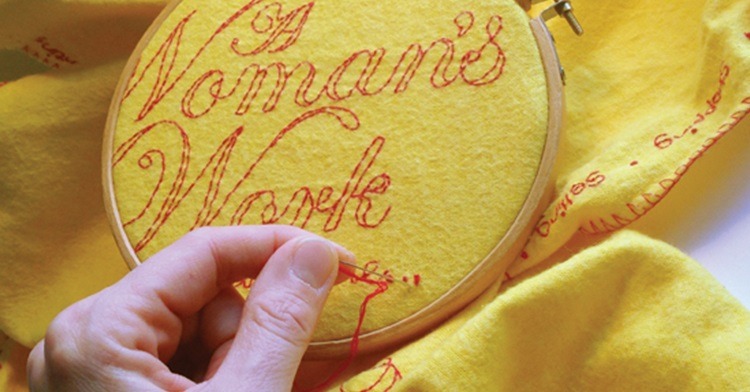
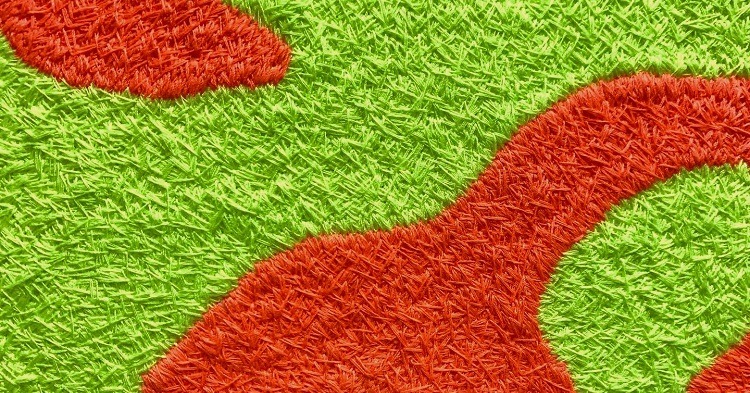
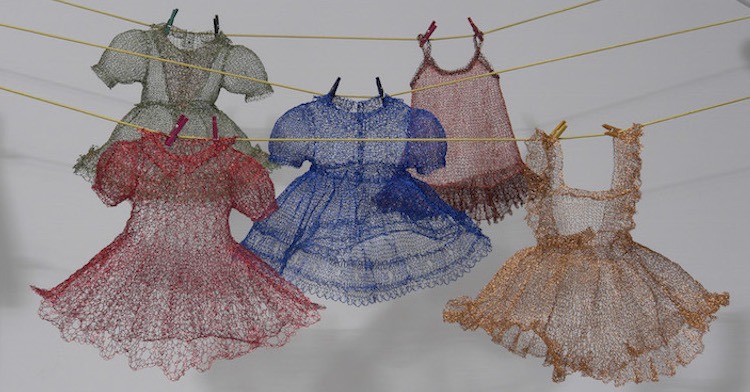
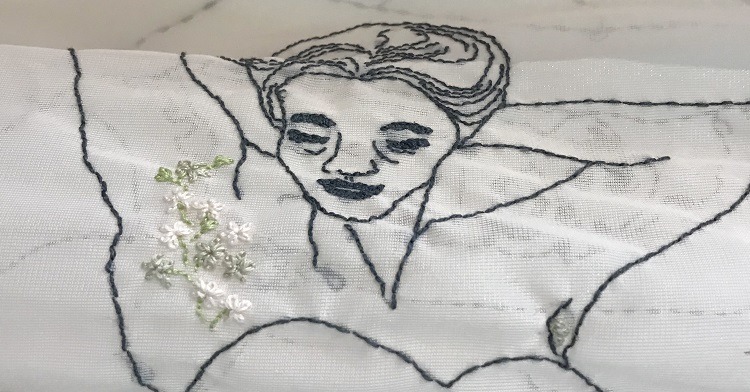
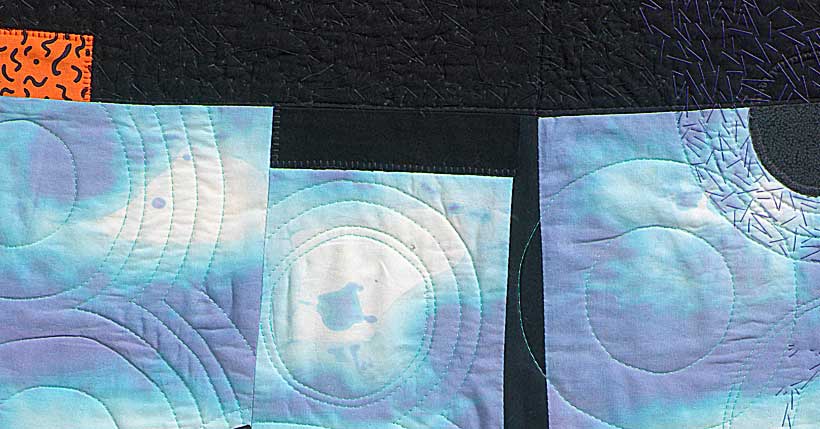
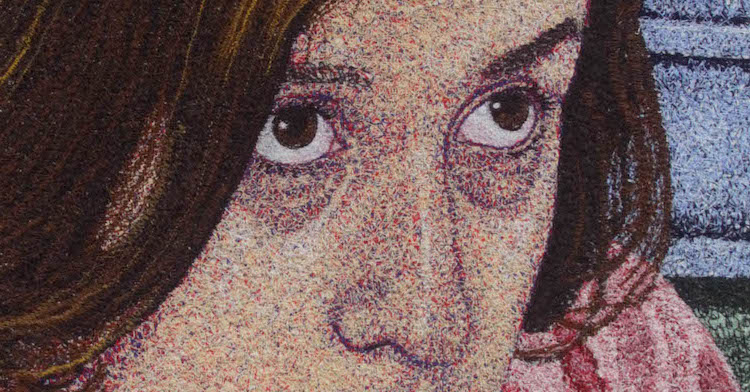
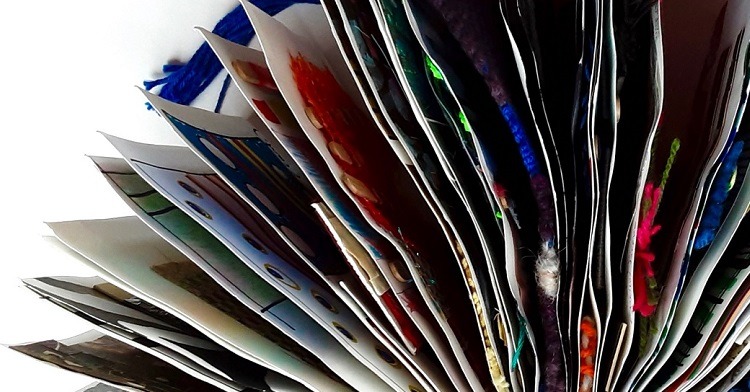
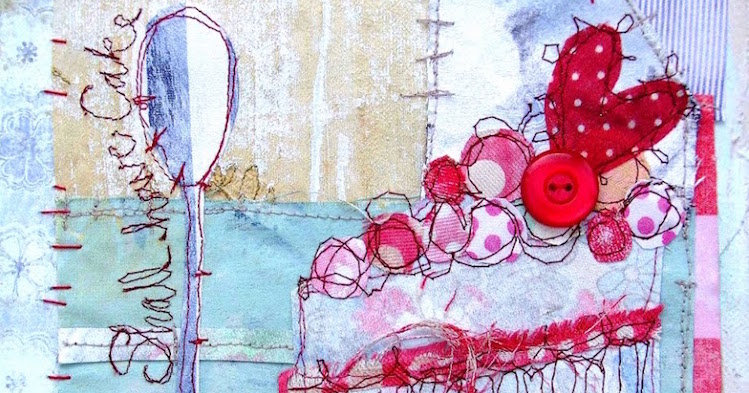
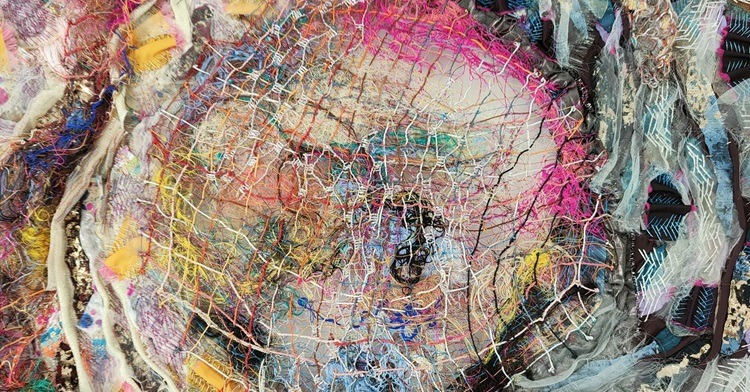
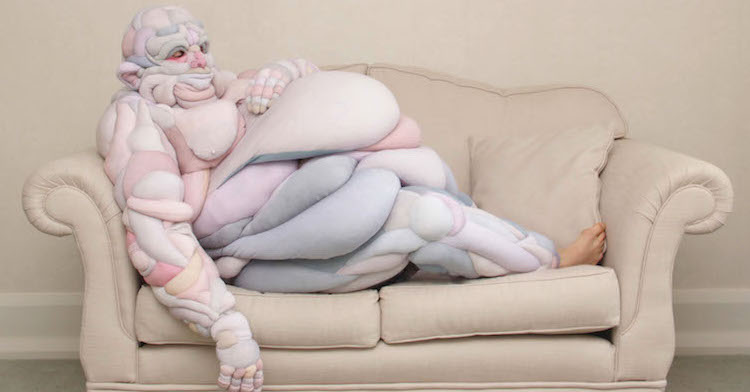
Comments